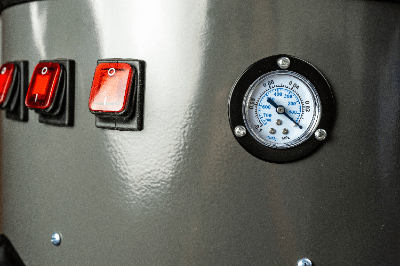What Is a Vacuum Pressure Gauge?

A vacuum pressure gauge is a pressure measuring instrument that measures negative pressure below atmospheric pressure.
There are three types of pressure gauges: pressure gauges, compound gauges, and vacuum gauges. Each of these instruments has a different range of pressure that can be measured: a manometer can measure only positive pressure, a compound gauge can measure a limited range of positive and negative pressure, and a vacuum pressure gauge can measure only negative pressure.
Therefore, care should be taken not to use vacuum gauges for measurements other than negative pressure, as this may cause malfunctions.
Uses of Vacuum Pressure Gauges
Vacuum pressure gauges are used in plasma etch spaces in semiconductor manufacturing equipment, metallurgy, organic synthesis, and other laboratory facilities. Other applications include ion beam equipment, vapor deposition equipment, and processing facilities requiring surface cleanliness.
For operations in which air is removed from piping to create a vacuum and then fill the piping with gas, vacuum pressure gauges are used to measure the degree of vacuum. A familiar example is when installing a new air conditioner.
By filling the inside of the air conditioner piping with cooling gas only, the air conditioner can be operated without malfunction.
Principle of Vacuum Pressure Gauges
There are three main methods for measuring vacuum pressure: mechanical phenomena, gas transport phenomena, and gas ionization phenomena.
1. Mechanical Phenomena
Measurements using mechanical phenomena can be made with U-tube manometers, McLeod vacuum gauges, diaphragm vacuum gauges, Bourdon tube vacuum gauges, and dead-weight vacuum gauges.
U-Tube Manometer
This differential pressure gauge is a glass U-tube, one end of which is sealed by exhausting it into a vacuum. It is capable of reading the pressure difference of gases from the height of the liquid column produced by the pressure difference, and is not affected by the type of gas. Therefore, it can measure absolute values of pressure.
McLeod Vacuum Gauge
This mercury liquid column pressure gauge is designed to measure high vacuum pressure. It is equipped with a mechanism that compresses gas to expand pressure and can measure absolute pressure.
Diaphragm Vacuum Gauges
This method reads the amount of deformation caused by pressure on the diaphragm mechanically, optically, or electrically.
2. Gas Transport Phenomena
A thermal conductivity vacuum pressure gauge is a vacuum pressure gauge that makes use of the gas transport phenomenon. It utilizes the property that the thermal conductivity of a gas varies with pressure.
There are many types of thermal conductivity vacuum gauges, including Pirani vacuum gauges, thermistor vacuum gauges, and thermocouple vacuum gauges. The important point to note about thermal conductivity vacuum gauges is that, at high vacuum, the effect of thermal radiation is greater than that of thermal conductivity. Therefore, thermal conduction vacuum gauges have the disadvantage that they cannot be used to measure high vacuum.
The Pirani vacuum gauge is a measuring instrument that detects changes in electrical resistance. It is based on a method in which an electric current is applied to a thin platinum resistance wire, and the change in platinum resistance due to heat lost by collision of gas molecules is detected by a bridge circuit.
3. Ionization Phenomena of Gases
This method uses the phenomenon of gas ionization to measure vacuum. There are several types of vacuum gauges, including hot cathode ionization vacuum gauges, cold cathode ionization vacuum gauges, and radiation vacuum gauges.
Hot Cathode Ionization Vacuum Gauge
The hot cathode emits thermal electrons to ionize the gas, and the ions produced are measured.
Cold Cathode Ionization Vacuum Gauge
This method ionizes gas by cold cathode discharge and measures ions.
Radiation Vacuum Gauge
Measures ions produced by radiation.
How to Select a Vacuum Pressure Gauge
Because there are numerous types of vacuum pressure gauges, the appropriate vacuum gauge must be selected for the intended purpose. The vacuum space for the purpose of measurement can be classified as low vacuum, medium vacuum, high vacuum, or ultrahigh vacuum.
- Low vacuum (low vacuum) : 105Pa~102Pa
- Medium vacuum (medium vacuum) : 102Pa~10-1Pa
- High vacuum (high vacuum) : 10-1Pa~10-5Pa
- Ultra-high vacuum (ultra high vacuum) : 10-5Pa~10-8Pa
- Extremely high vacuum (extremely high vacuum) : 10-8Pa以下
U-tube mercury manometers and diaphragm vacuum gauges can measure in the low vacuum range. McLeod vacuum gauges can measure from high vacuum to low vacuum.
Pirani vacuum gauges are able to measure in the region of low to medium vacuum, and ionization vacuum gauges measure in the region of medium to ultra-high vacuum.